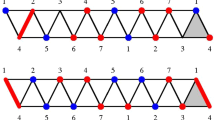Abstract
We construct d-dimensional pure simplicial complexes and pseudo-manifolds (without boundary) with n vertices whose combinatorial diameter grows as \(c_d n^{d-1}\) for a constant \(c_d\) depending only on d, which is the maximum possible growth. Moreover, the constant \(c_d\) is optimal modulo a singly exponential factor in d. The pure simplicial complexes improve on a construction of the second author that achieved \(c_d n^{2d/3}\). For pseudo-manifolds without boundary, as far as we know, no construction with diameter greater than \(n^2\) was previously known.
Similar content being viewed by others
Notes
The standard usage is to consider all faces, not only facets, as elements of C, and then call facets the maximal ones. Our approach is equivalent and, for our purposes, simpler.
C is a pseudo-manifold with boundary if ridges are contained in at most two facets, the boundary of C consisting of the ridges lying in only one facet. Standard usage is to say “pseudo-manifold” alone meaning “without boundary” and “pseudo-manifold with boundary” when boundary is allowed. But to avoid confusion we here insist in saying “without boundary” when boundary is forbidden.
References
Abbott, H.L., Katchalski, M.: On the snake in the box problem. J. Comb. Theory, Ser. B 45(1), 13–24 (1988)
Adler, I., Dantzig, G.B.: Maximum diameter of abstract polytopes. In: Balinski, M.L. (ed.) Pivoting and Extensions. Mathematical Programming Studies, vol. 1, pp. 20–40. Springer, Berlin (1974)
Edmonds, J.: Euler complexes. In: Cook, W., Lovász, L., Vygen, J. (eds.) Research Trends in Combinatorial Optimization, pp. 65–68. Springer, Berlin (2009)
Eisenbrand, F., Hähnle, N., Razborov, A., Rothvoß, T.: Diameter of polyhedra: limits of abstraction. Math. Oper. Res. 35(4), 786–794 (2010)
Kalai, G. et al.: Polymath 3: Polynomial Hirsch Conjecture, September 2010. http://gilkalai.wordpress.com/2010/09/29/polymath-3-polynomial-hirsch-conjecture
Kim, E.D.: Polyhedral graph abstractions and an approach to the Linear Hirsch Conjecture. Math. Program. 143(1–2), 357–370 (2014)
Lidl, R., Pilz, G.: Applied Abstract Algebra. Undergraduate Texts in Mathematics, 2nd edn. Springer, New York (1998)
Santos, F.: A counter example to the Hirsch Conjecture. Ann. Math. 176(1), 383–412 (2012)
Santos, F.: Recent progress on the combinatorial diameter of polytopes and simplicial complexes. TOP 21(3), 426–460 (2013)
Todd, M.J.: A generalized complementary pivoting algorithm. Math. Program. 6(1), 243–263 (1974)
Végh, L.A., von Stengel, B.: Oriented Euler complexes and signed perfect matchings. Math. Program. 150(1), 153–178 (2014)
Acknowledgements
Work of Francisco Santos is supported in part by the Spanish Ministry of Science (MICINN) through Grant MTM2014-54207P.
Author information
Authors and Affiliations
Corresponding author
Additional information
Editor in Charge: Günter M. Ziegler
Rights and permissions
About this article
Cite this article
Criado, F., Santos, F. The Maximum Diameter of Pure Simplicial Complexes and Pseudo-manifolds. Discrete Comput Geom 58, 643–649 (2017). https://doi.org/10.1007/s00454-017-9888-5
Received:
Revised:
Accepted:
Published:
Issue Date:
DOI: https://doi.org/10.1007/s00454-017-9888-5



